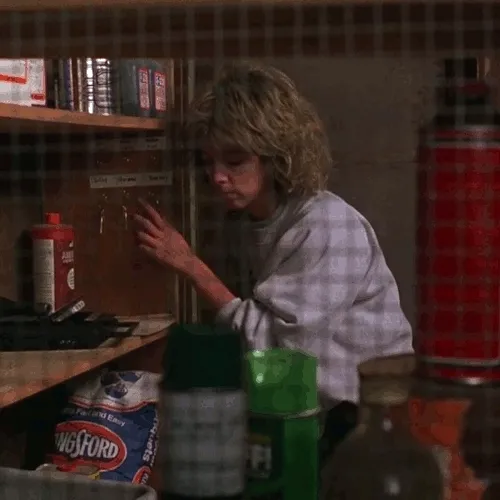There’s this moment in Sleepaway Camp III that I catch on most watch‑throughs, and it just fascinates me.
The sequence above is only a few frames long: Angela looks down, reaches for the keys, then suddenly stares straight into the camera before turning away. It’s blink‑and‑you’ll‑miss‑it, but once you notice it, it’s impossible to unsee.
Why does she do it?
Was this a deliberate choice — a meta wink from the director or writer, acknowledging the audience watching these brutal shenanigans unfold? Or was it Pamela Springsteen herself, slipping in a sly improvisation?
Of course, the simplest explanation is that it’s just another example of Springsteen’s uneven acting; a compulsion to look at the camera. But the moment is so pointed, so oddly intimate, that it feels intentional — like Angela is staring directly into our souls, daring us to keep watching.
Angela Baker: Complicated Anti‑Antagonist
This is Angela — spoiler‑ish — the unrepentant slasher anti‑antagonist of the second and third films in the Sleepaway Camp franchise. The moment appears in Sleepaway Camp III: Teenage Wasteland, the sequel to Sleepaway Camp II: Unhappy Campers.
I say spoiler‑ish because, of course, this was spoiled in the trailer and in the previous movies.
If you want to dive deeper into Angela Baker, the Fandom Villains Wiki entry is a good place to start.
Angela is fascinating because she’s layered: she has trauma, a difficult past, and a strangely effective comedic delivery (intentional or not). She’s watched loved ones die, been abused by a caregiver, and now she just kills and kills.
The Twist and Its Complications
Some folks will insist on pointing out that Angela is technically a transgender character, born Peter Baker. That’s the twist of the original film, when we learn that Angela has a penis. It’s shocking because she’s portrayed by biologically female actors.
But here’s the thing: the franchise canon establishes that Baker has undergone years of therapy and sexual reassignment surgery and is, now, truly a woman.
That whole aspect of the IP is fascinating — originally meant to shock, but now a strange cultural artifact of how horror once used gender identity as a twist.
Murder, Comedy, and B‑Horror Charm
Complicating our feelings further: practically everyone Angela kills in the sequels is insufferable. You don’t really care that she’s killing them.
The second and third films stand out because they were filmed back‑to‑back at the same Georgia location, giving them the feel of a self‑contained cycle. They’re a testament to late‑80s slasher B‑horror comedy cinema — cheap, campy, and oddly endearing.
That Glance Into the Camera
This is why the key‑picking moment hits so hard. Angela, played by Pamela Springsteen — sister of Bruce Springsteen, music legend and American icon from New Jersey — suddenly breaks the invisible wall.
The camera has been a silent, unseen observer. And then she looks right into it, like she’s staring into us.
It’s brief but very pointed. Impossible not to see once you’ve noticed it. And impossible not to wonder if it was intentional.
Horror as a Mirror
The films themselves are, largely, terrible. But they’re terrible in all the right ways. I love horror. I wouldn’t call myself an expert, but I’ve seen a lot of it. And I almost always find a way to appreciate the effort behind it — especially slashers with practical effects.
The acting is awful, the story is pedestrian, the kills are unrealistic, and the plot holes are enormous. But people tried. Effort was exerted. And ultimately, art was created.
That said, the villainization of transgender folks shouldn’t be a trope. This isn’t the representation transgender people deserve. Yet the Sleepaway Camp franchise stands as a strange signpost: unintentionally progressive in some ways, while also showing how unprogressive the times were.
In the 80s and 90s, “gay” was still thrown around as a slur — shorthand for “stupid” or “awful.” Horror, like all art, reflects its era, and sometimes that reflection is ugly.
Why I Keep Coming Back
That fleeting glance into the camera is what keeps me returning. In a franchise full of cheap kills and campy dialogue, it’s the one moment where Angela seems to see us — and maybe asks us why we’re still watching. It’s moments like these that keep me watching horror.
And that’s what horror does best: it magnifies society’s problems through a cracked, blood‑splattered lens. It’s not always pretty, but it’s always telling us something.
In the meantime, if you’re curious about what else I’ve watched this Horror Movie Season, checkout my profile on my newly created horror tracker. As of this writing I’ve watched 68 movies this season (which I began September 1st this year).
